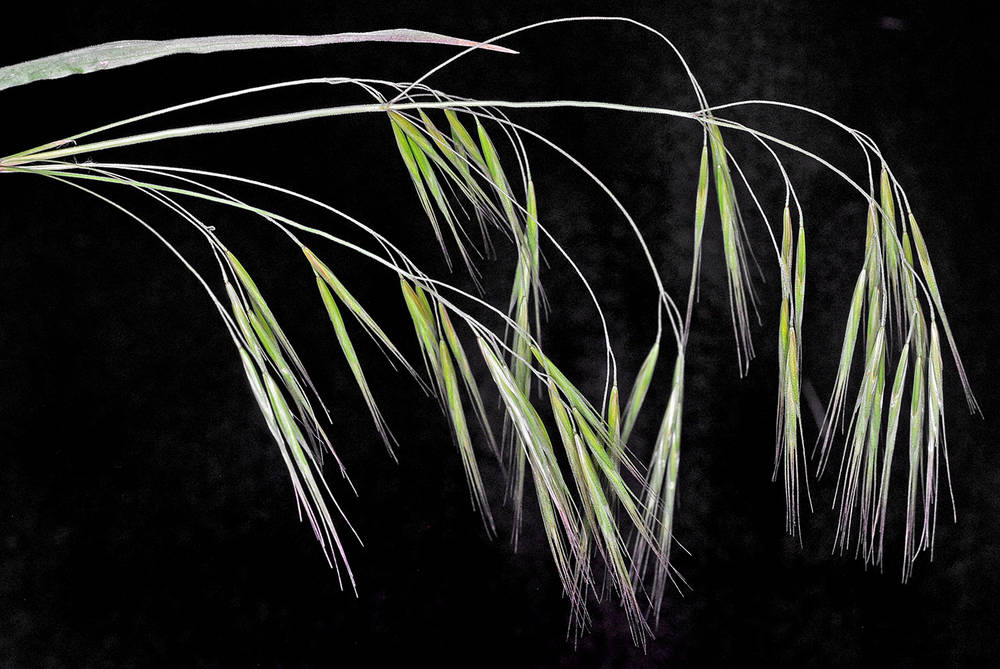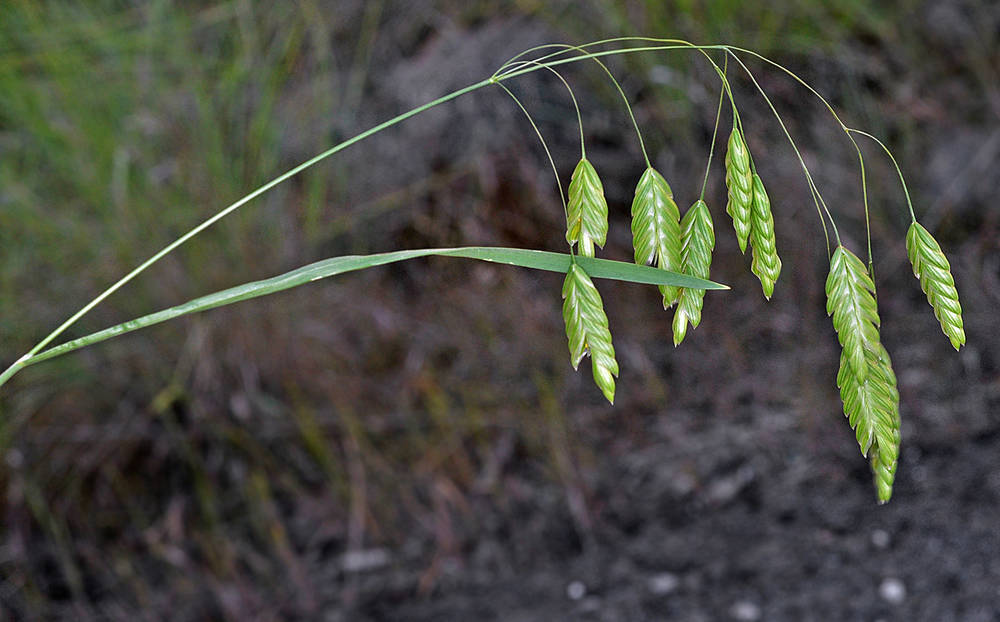Bromus tectorum
Bromus briziformis
cheatgrass, downy brome, downy chess
rattlesnake brome
puberulent.
sheaths densely and softly retrorsely pubescent to pilose; upper sheaths sometimes glabrous;
blades 1–16 cm × 1–6 mm, softly hairy on both surfaces.
sheaths densely pilose;
blades 3–13 cm × 2–4 mm, pilose to pubescent on both surfaces.
5–20 × 3–8 cm; open, nodding;
branches 1–4 cm, drooping, 1-sided and longer than the spikelets, usually at least 1 branch with 4–8 spikelets.
5–15 × 3–7 cm; open, nodding;
pedicels sometimes longer than the spikelets, curved to reflexed.
10–20 mm, moderately laterally compressed, not densely crowded, 4–8 florets.
15–30 × 8–12 mm; ovate, laterally compressed, usually dangling, with 9–15 florets;
floret bases usually concealed at maturity;
rachilla internodes concealed at maturity.
villous, pubescent, or glabrous;
lower glumes 4–9 mm, 1-veined;
upper glumes 7–13 mm, 3–5-veined.
smooth or minutely scabrous;
lower glumes 5–6 mm, 3–5-veined;
upper glumes 6–8 mm, 7–9-veined.
about as long as the paleas.
9–12 mm, lanceolate, glabrous or pubescent to pilose, 5–7-veined;
tips acuminate; hyaline; bifid, with teeth 0.8–2(3)mm, awned;
lemma awns 10–18 mm; straight.
9–10 mm long, 6–8 mm wide, inflated, obovate or rhombic; leathery; smooth or scabridulous, obscurely 9-veined;
veins usually not raised and thickened;
margins hyaline, 1–1.3 mm wide, abruptly angled, not inrolled at maturity;
tips acute to obtuse; bifid;
teeth shorter than 1 mm, usually awnless;
lemma awns; if present; to 1 mm, arising less than 1.5 mm below the lemma tips.
0.5–1 mm.
0.7–1 mm.
=14.
=14.
Bromus tectorum
Bromus briziformis
Disturbed areas, sagebrush steppe, degraded grasslands, roadsides. 0–2400 m. BR, BW, Casc, Col, CR, ECas, Lava, Owy, Sisk, WV. CA, ID, NV, WA; throughout North America; worldwide. Exotic.
Bromus tectorum is a relatively short grass with drooping inflorescences. Similar B. sterilis and B. diandrus have longer glumes, lemmas, and awns, and spikelets that hang down at a shallower angle than those of B. tectorum. The introduction of B. tectorum to shrub steppe habitats during a time of massive overgrazing in the late 1800s has made restoration of native plant communities difficult or impossible, even where grazing no longer occurs. Fast-growing B. tectorum seedlings outcompete slower growing native grass seedlings for water in drying soils. At maturity, the awns make B. tectorum unpalatable to livestock.
Disturbed places, roadsides, forest openings, sand dunes, overgrazed rangeland. 0–1800 m. BR, BW, Col, ECas, Lava, WV. CA, ID, NV, WA; throughout North America; southwestern Asia, Europe. Exotic.
Unusual inflated florets make Bromus briziformis unique among Oregon bromes, but it can be confused with Briza maxima. In the latter species, the florets spread more widely, so that the angle between the glumes is almost 180°. Records of B. briziformis west of the Cascades have often been misidentified B. maxima. The dry, mature inflorescences of this species look somewhat like the tails of rattlesnakes and also make a disturbing rattling sound as one walks through a population of ripe plants.
Barbara Wilson, Richard Brainerd, Nick Otting
Barbara Wilson, Richard Brainerd, Nick Otting
- Local floras:
BC,
CA,
OR,
WA
- Local Web sites:
CalFlora,
CalPhotos,
Flora NW,
PNW Herbaria
WildflowerSearch
iNaturalist (observations)
USDA Plants Database
- LBJ Wildflower Center
- SEINet
- Plants of the World Online
- Encyclopedia of Life
- Wikipedia
- Google Image Search
- Local floras:
BC,
CA,
OR,
WA
- Local Web sites:
CalFlora,
CalPhotos,
Flora NW,
PNW Herbaria
WildflowerSearch
iNaturalist (observations)
USDA Plants Database
- LBJ Wildflower Center
- SEINet
- Plants of the World Online
- Encyclopedia of Life
- Wikipedia
- Google Image Search





